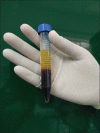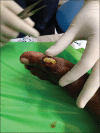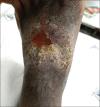Comparison of Efficacy of Autologous Platelet-rich Fibrin versus Saline Dressing in Chronic Venous Leg Ulcers: A Randomised Controlled Trial
- PMID: 28529414
- PMCID: PMC5418991
- DOI: 10.4103/JCAS.JCAS_137_16
Comparison of Efficacy of Autologous Platelet-rich Fibrin versus Saline Dressing in Chronic Venous Leg Ulcers: A Randomised Controlled Trial
Abstract
Background: Venous leg ulcer is a chronic condition, and various treatment modalities are available. Platelet-rich fibrin (PRF) is one of the newer modalities and it contains fibroblast growth factor (GF), vascular endothelial GF, angiopoitin and platelet-derived GF which enhances the wound healing. Hence, we conducted a randomised controlled trial to compare the efficacy of PRF versus saline dressing in chronic venous leg ulcers.
Aim: This study aims to compare the efficacy of autologous PRF with saline dressing in patients with chronic venous leg ulcer and to compare the mean reduction in ulcer area at the end of 4 weeks.
Materials and methods: Fifteen patients with chronic venous leg ulcers of >6 months duration having an ulcer area of 1 cm × 1 cm to 5 cm × 5 cm were taken into the study and were randomly divided into two groups. Group 1: Patients received PRF dressing. Ten millilitres of patient's blood was taken and centrifuged at 3000 rpm for 15 min. A fibrin clot obtained in the middle of the tube was removed and used for dressing over the wound surface. It was repeated every week for 4 weeks. Group 2: Patients received saline dressings once a week for 4 weeks. The assessment of the ulcer size was done with the help of photographs, and ulcer area was measured.
Results: The mean reduction in the area of the ulcer size in PRF group was 85.51%, and the mean reduction in the area of the ulcer size in Saline group was 42.74% which was statistically significant with a P < 0.001 and t = 4.11.
Conclusion: We conclude that PRF dressing can be used as it is effective, inexpensive, safe and an outpatient procedure.
Keywords: Platelet-rich fibrin; saline; venous ulcers.
Conflict of interest statement
There are no conflicts of interest.
Figures











References
-
- Bergqvist D, Lindholm C, Nelzén O. Chronic leg ulcers: The impact of venous disease. J Vasc Surg. 1999;29:752–5. - PubMed
-
- Mayer W, Jochmann W, Partsch H. Varicose ulcer: Healing in conservative therapy. A prospective study. Wien Med Wochenschr. 1994;144:250–2. - PubMed
-
- O'Connell SM, Impeduglia T, Hessler K, Wang XJ, Carroll RJ, Dardik H. Autologous platelet-rich fibrin matrix as a stimulator of healing of chronic lower extremity ulcers. Wound Repair Regen. 2006;14:A76. - PubMed
-
- Margolis DJ, Kantor J, Santanna J, Strom BL, Berlin JA. Effectiveness of platelet releasate for the treatment of diabetic neuropathic foot ulcers. Diabetes Care. 2001;24:483–8. - PubMed
LinkOut - more resources
Full Text Sources
Other Literature Sources
Medical

